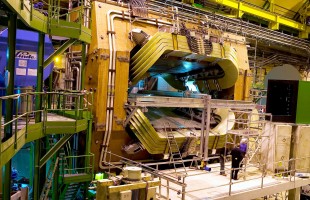As of this Monday, four of the first six frames of light-sensitive SciFi detectors are in place at the LHCb experiment at CERN. SciFi was partly designed and built by Nikhef.
The two remaining frames are also expected to be finished and placed in the coming weeks. After that, the beam pipe of the LHC accelerator can be put back in place. The accelerator was closed for repairs and upgrades for the past two years.
The other six frames will be added later at the other side of the beam pipe. In September, CERN plans to start testing the refurbished accelerator and prepare it for restart in 2022.
The six frames make up half of the SciFi unit in LHCb. SciFi consists of frames with 4.8-meter-long mats of scintillating glass fibers, which convert the passage of electrically charged particles from proton collisions in the LHC into a light signal. That light is picked up and processed at the end of the mats with sensors.
Of particular note is that the light sensors at the ends of the scintillating fibers must be cooled to 40 degrees below zero. To prevent ice formation in these cold-boxes, dry nitrogen gas is blown through the setup. The coolant itself runs through vacuum-insulated double-walled tubes.
After many delays due to travel restrictions because of covid 19, Nikhef engineers completed assembly of the first four frames in April. On Monday, in radiant weather at the CERN site in Geneva, these were driven to the LHCb site and hoisted through the shaft to the underground experiment. There they were immediately moved into place. The remaining two frames should follow soon.
In addition to the cold-boxes for SciFi, Nikhef is also contributing to the VELO detector, the device that can pinpoint the collision site of protons extremely precisely in LHCb. Its production is still in full swing, including at Nikhef in Amsterdam.
The LHCb experiment is one of four large detector experiments at the LHC accelerator at CERN. The experiment is designed, among other things, to find differences between matter and antimatter. Recently, the experiment was in the news with clues to a surprising difference between electrons and their heavier version, muons.
